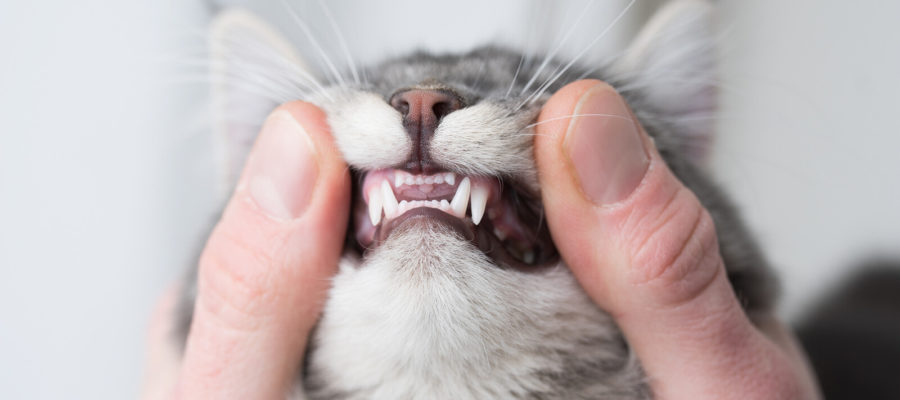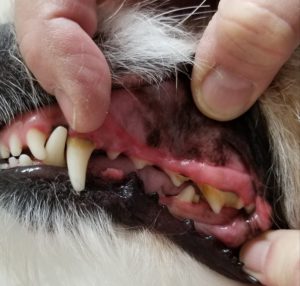Be Down in Your Pet’s Mouth: Identifying and Preventing Five Dental Issues In Dogs and Cats

By Arden Moore – The Pet Health and Safety Coach™
You may love wiggling a wand toy for your ready-to-pounce cat or engage your dog in a friendly game of fetch in the back yard. Both activities help bolster the bond between you and your pets. Another one of the best ways to show love for your pet is to be down in his mouth – literally. Keeping tabs on your pet’s dental health can stave off many future problems and make any doggy kiss more fresh smelling and welcoming. Did you know, according to the American Veterinary Dental College, by the age of three 80% of dogs and 70% of cats develop some degree of periodontal disease? In honor of February being National Pet Dental Health Month, here’s your opportunity to step up your proactive dental game.
“One of the best habits to get into is to regularly ‘flip the lip’ of your pet and check inside and yes, take a sniff,” says Michael Wiegand, DVM, DAVDC, a board-certified veterinary dentist who operates the Florida Animal Dentistry and Oral Surgery Center in West Palm Beach and Stuart in Florida. By regularly practicing at-home preventive care, you may help your pet dodge serious dental woes and may even reduce the chance of your pet requiring yearly professional dental cleanings at the veterinary clinic that can take a big bite out of your wallet.
Here are the top five mouth issues to know about:
 TARTAR BUILDUP ON THE TEETH – ESPECIALLY THE BACK MOLARS
TARTAR BUILDUP ON THE TEETH – ESPECIALLY THE BACK MOLARS
Many dogs, like Kona, my terrier-mix, love to unleash a wide, grin when they feel happy. All of their teeth should be white. But neglected, these teeth can yellow and be covered in a colorless film of bacteria known as plaque that can develop into hardened plaque better known as tartar.
At-home care: You can start brushing your pet’s teeth every day. To get your pet used to having your hand in his mouth, consider starting by wrapping gauze around your index finger and rubbing inside the cheek surfaces. Then advance to a finger brush or toothbrush sized for pets. Never give human toothpaste to your pet because many brands contain an artificial sweetener known as xylitol that can lower blood sugar, cause seizures and even lead to liver failure.
Or you can go brushless. Check out the family of Oratene® veterinarian-approved brushless products. They feature a patented enzyme formula that doesn’t require brushing and works to freshen breath, clean teeth, balance oral flora, keep plaque at bay, and much more. The products include a drinking water additive, a gentle mister freshening spray, and a brushless toothpaste gel.
YUCKY BREATH
No one wants a dog whose nickname is Halitosis. Bad breath is more than just an unwelcoming odor coming from your ready-to-kiss-you dog. It can signal bacteria buildup in the mouth. Veterinary dentists have identified more than 400 different types of bacteria in the oral cavities of dogs and cats. It could also be a stinky clue your pets’ mouth isn’t healthy or that one or more of your pet’s organs are ailing and not performing at 100 percent or that something is wrong inside the gastrointestinal tract.
At-home care: Get in the daily habit of sniffing inside your pet’s mouth. Report any foul-smelling issues to your veterinarian for prompt treatment. A healthy mouth will generally not be stinky. Remember to reward your pet with a treat so he will associate you handling his mouth with a positive experience and a tasty reward.
LOOSE OR BROKEN TEETH
Adult dogs sport 42 teeth and adult cats have 30. Even though these teeth are strong, they are not invincible to diseases. Cats can be prone to tooth resorption which can lead to tooth loss. Dogs can loosen or chip their teeth by gnawing on hard objects.
At-home care: Carefully select chew and tug-of-war toys for your pet. Resist giving your dog antlers, cow hoofs, ice cubes, or nylon, unbending chew toys. “Dogs have half the enamel thickness people dog but can bite with five times the strength of humans,” says Dr. Wiegand. “Instead, treat them to bendable chew toys like stuffed Kongs. Chews should be pliable and have some give.”
 DRY MOUTH
DRY MOUTH
Known medically as xerostomia, this condition simply means that your pet’s mouth does not have enough saliva to properly produce protective benefits inside the mouth. When this happens, an overgrowth of bacteria can occur due to an imbalance of the oral flora. The first sign of Dry Mouth is usually very bad breath. Dry mouth is identified by such symptoms as thick, tacky saliva, dry cracked tongue, and ulcerations or mouth sores. The leading contributor of this condition is in reaction to certain medications your pet may need to treat blood pressure, anxiety, pain, osteoarthritis, allergies, and other conditions.
At-home care: Consult with your veterinarian about top-quality food to feed your pet and make sure your pet has access and is encouraged to drink plenty of water every day. It’s also a good idea to select oral care products which can help to balance the oral flora. You can do what I do and add Oratene Enzymatic Brushless Water Additive every morning when I clean out and re-fill my pets’ water bowls.
BLEEDING AND/OR RED GUMS
Gingivitis occurs when bacteria develop along your pet’s gum line, causing inflammation and pain. This happens when tartar builds up at and below the gum line.
At-home care: Keeping your pet’s teeth clean and establishing a daily routine is the best defense against the development of gingivitis. I also recommend you lift your pet’s lip daily and look for redness, bleeding, or gums growing up the side of the tooth, which could mean that there is a hole in the tooth. Pay attention to your pet’s eating habits. If your cat or dog is dropping food a lot, losing weight, having halitosis, drooling excessively, or bleeding from the gums, please alert your veterinarian sooner than later.
For your pet’s health sake, invest in preventive dental care. Report to your veterinarian any changes you see or smell without delay. When an issue is found in the mouth and fixed, your dog or cat will be pain-free and feel his healthy best.
 To learn more about Arden Moore, click here.
To learn more about Arden Moore, click here.

